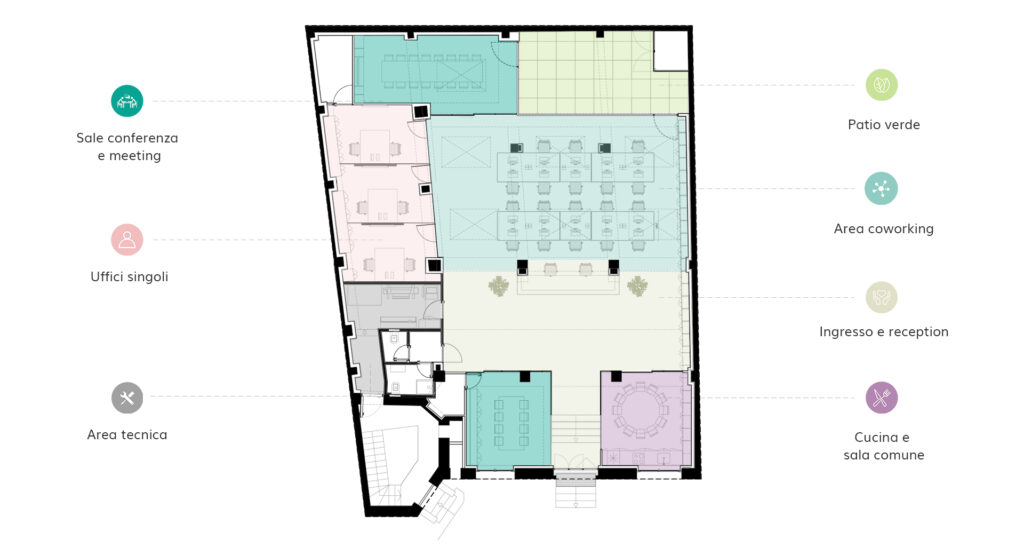Interior renovation and basement conversion
Via Canonica
Type
Location
via Canonica, Milan
Year
2019
Surface area
360 m2
Client
Studio DC10
Head Designer
Arch. Marco Vigo, Arch. Alessia Garibaldi
Construction Management
Ing. Giorgio Piliego
Professional services
Concept, architectural and interior design, artistic direction, construction management
Via Canonica
The physical space of our work is the manifesto of our thinking. Studio DC10 is based in a former Milanese carpentry workshop, which has been recovered and transformed into a laboratory for architecture. Located in the center of Milan, near the Arena (stadium), the space is immersed in the traditional urban fabric but is characterized by a modelling of the environments arising from contemporary needs.
The spatial redefinition uses the “floor” element as a matrix to generate solids and voids. This creates a large open space punctuated by large skylights through which a diffused zenithal light enters, an environment that can be configured into infinite variations. The subtraction of parts of the existing floor also allows the creation of a fully glazed patio that features greenery. A continuity is created between the outdoor and indoor vegetation, in a continuum that amplifies the space and blurs the distinction between open and closed.



The design of the offices concentrated mainly on environmentally friendly materials, introducing green elements into the work space such as plants and flowers, even in enclosed spaces, both in the work tables and in the flush planters.
The regenerative effect of plants in work environments is evident and helps to recreate the cognitive sustainability that only contact with nature can give us. Users’ perception increases in value and the well-being that is felt is objective.
Another element that characterized the design was that of harmonizing the presence of shared working spaces with the conference rooms and the private offices, designed and arranged around the large open space. With a visual continuity enabled by sliding glass partitions, inspired by Japanese screens that guarantee the flow of light and eliminate visual barriers, the glazing consists of geometric panes in natural oak frames.

The structural elements have been returned to their natural state, so the pillars are made of exposed concrete and the reception area echoes them, becoming a sculptural partition element. Most of the systems and technical parts have been left exposed and follow the supporting structure, and are coloured black.
All the furniture is two-toned natural and dark grey MDF, designed by DC10 specifically for the spaces and the result of our experience honed over many years in custom projects.
Particular attention was paid to studying the indoor lighting, developed with the firm Flos; the most iconic elements are the pieces by Anastassiades – suspended above the reception desk – and the Taraxacum by Castiglioni – above the dining table.
In the conference rooms, particular focus has been given to the materials library with the display of materials that best represent the Studio’s stylistic signature, the basic colour palette is still neutral with the use of natural materials, the choice of objects and art works is tailored to the different projects.
The communal desks in the open space are made of two-tone dark gray MDF for the tops and sides, natural MDF for the profiling and the lift towers.
A custom-made cable channel is hidden in the large tables and has concealed top access. Along the length of the tables, a series of metallic trays have been designed to store accessories that are raised on wooden circular supports with changeable positions, in the Memphis school colours.
The side bookcase, again two-toned, accentuates the depth of the room by taking up the entire length of the space. So it is positioned in visual continuity between the kitchen area and the open space. The central part of the natural MDF bookcase is open and divides the two pieces of furniture, separating the dark grey parts of the cupboards and leaving the upper part suspended.
The kitchen area was custom designed in Carrara marble and grey MDF units. The team meets here for shared lunches around the large round table. This table, made of MDF with a grey top engraved with a rectangular pattern and bordered in blue like the metallic legs, is a tribute to Jean Prouvé.
From the outside, the entrance features two large weathering steel planters and the old wooden door, partially restored, with the central part of new glass enclosed within a metal frame. Access to the interior is via an open staircase covered with Carrara marble. Inside, the entrance is protected by a velvet multi-coloured curtain that draws the eye upward to the custom-made neon DC10 logo welcoming visitors.

Pubblicazioni
- OFARCH – November 2019 n.150
- Officelayout – July – September 2019 n.178
- IoArch – May 2019 n. 81




